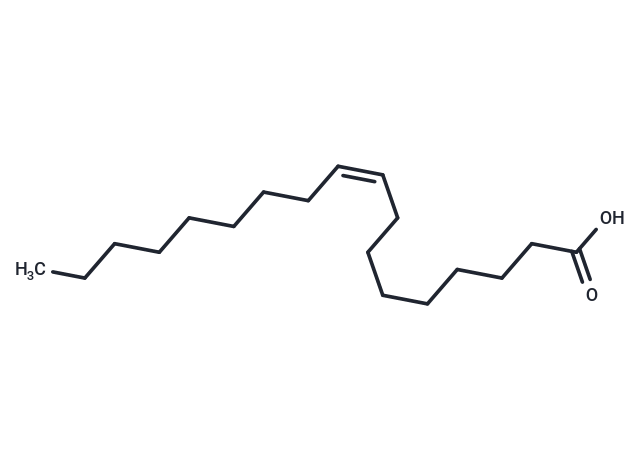Shopping Cart
- Remove All
 Your shopping cart is currently empty
Your shopping cart is currently empty

Oleic acid (Glycon Wo) is a natural product, a common monounsaturated fatty acid found in a variety of animal and vegetable fats and oils. Palmitic acid is a Na+/K+ ATPase activator.

| Pack Size | Price | Availability | Quantity |
|---|---|---|---|
| 500 mg | $30 | In Stock | |
| 1 g | $40 | In Stock | |
| 5 g | $87 | In Stock | |
| 1 mL x 10 mM (in DMSO) | $60 | In Stock |
| Description | Oleic acid (Glycon Wo) is a natural product, a common monounsaturated fatty acid found in a variety of animal and vegetable fats and oils. Palmitic acid is a Na+/K+ ATPase activator. |
| In vitro | METHODS: Human tumor cells HCG-27, AGS, MDA-MB-231, SGC7901, BGC823 and MCF-7 were treated with Oleic acid (400 μM) for 24-72 h. Cell viability was detected using MTT.
RESULTS: Oleic acid stimulated cell viability in HGC-27, MDA-MB-231 cells, and inhibited cell viability in AGS, SGC7901, BGC823 and MCF-7 cells. [1] METHODS: Renal cell carcinoma cells 786-O were treated with Oleic acid (0.05-0.2 mM/L) for 48 h. Apoptosis was detected by Flow Cytometry. RESULTS: Oleic acid retarded apoptosis of 786-O cells in a concentration-dependent manner. [2] |
| In vivo | METHODS: To detect the antitumor activity in vivo, Oleic acid (10 mg/kg) was administered by gavage to LKB1fl/flp53fl/fl endometrial tumor mouse model five days per week for four weeks.
RESULTS: Oleic acid treatment for four weeks significantly inhibited tumor growth by 52.1%.Oleic acid exhibits anti-tumor activity in endometrial cancers, which is dependent on the PTEN/AKT/mTOR signaling pathway. [3] METHODS: To study its role in ischemic injury, Oleic acid (10-30 mg/kg, 5% Tween 20 in sterile saline) was administered intraperitoneally to rodent models of middle cerebral artery occlusion (MCAO), photochromic and four-vessel occlusion (4-VO). RESULTS: Oleic acid administration reduced MCAO-induced infarct volume and functional deficits, photochromic-induced infarct volume, and 4-VO-induced hippocampal neuronal death. [4] |
| Alias | Oleate, Glycon Wo, Elaidoic acid, 9Z-Octadecenoic acid, 9-Octadecenoic Acid, 9-cis-Octadecenoic acid |
| Molecular Weight | 282.46 |
| Formula | C18H34O2 |
| Cas No. | 112-80-1 |
| Smiles | C(C/C=C\CCCCCCCC)CCCCCC(O)=O |
| Relative Density. | 0.89 g/cm3 at 25℃ (lit.) |
| Storage | store at low temperature | Powder: -20°C for 3 years | In solvent: -80°C for 1 year | Shipping with blue ice. | ||||||||||||||||||||||||||||||||||||||||
| Solubility Information | DMSO: 60 mg/mL (212.42 mM), Sonication is recommended. 5% DMSO+95% Saline: 3 mg/mL (10.62 mM), In vivo: Please add co-solvents sequentially, clarifying the solution as much as possible before adding the next one. Dissolve by heating and/or sonication if necessary. Working solution is recommended to be prepared and used immediately. | ||||||||||||||||||||||||||||||||||||||||
Solution Preparation Table | |||||||||||||||||||||||||||||||||||||||||
5% DMSO+95% Saline/DMSO
DMSO
| |||||||||||||||||||||||||||||||||||||||||

Copyright © 2015-2025 TargetMol Chemicals Inc. All Rights Reserved.